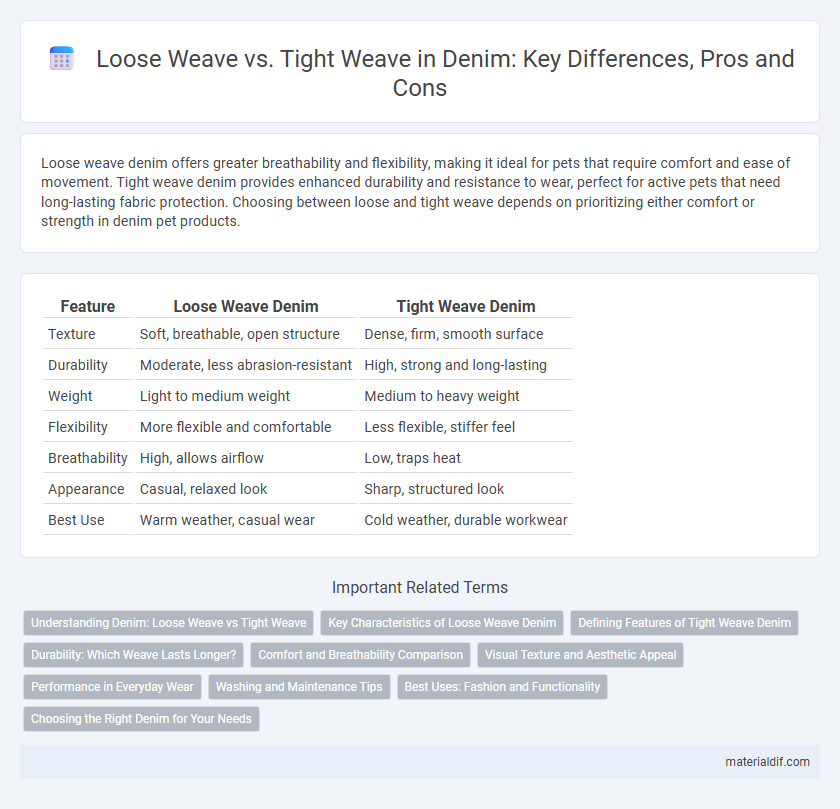Loose weave denim offers greater breathability and flexibility, making it ideal for pets that require comfort and ease of movement. Tight weave denim provides enhanced durability and resistance to wear, perfect for active pets that need long-lasting fabric protection. Choosing between loose and tight weave depends on prioritizing either comfort or strength in denim pet products.
Table of Comparison
| Feature | Loose Weave Denim | Tight Weave Denim |
|---|---|---|
| Texture | Soft, breathable, open structure | Dense, firm, smooth surface |
| Durability | Moderate, less abrasion-resistant | High, strong and long-lasting |
| Weight | Light to medium weight | Medium to heavy weight |
| Flexibility | More flexible and comfortable | Less flexible, stiffer feel |
| Breathability | High, allows airflow | Low, traps heat |
| Appearance | Casual, relaxed look | Sharp, structured look |
| Best Use | Warm weather, casual wear | Cold weather, durable workwear |
Understanding Denim: Loose Weave vs Tight Weave
Loose weave denim features a more open thread structure, providing greater breathability and a softer hand feel, ideal for warmer climates or casual, relaxed fits. Tight weave denim boasts densely packed threads, enhancing durability, crispness, and resistance to wear, making it preferred for structured garments and long-lasting jeans. Understanding the distinction between loose and tight weave denim helps consumers select fabric based on comfort, durability, and style preferences.
Key Characteristics of Loose Weave Denim
Loose weave denim features a more open construction of warp and weft threads, resulting in a softer and more breathable fabric. This type of denim offers greater flexibility and comfort, making it ideal for casual and relaxed-fit garments. The key characteristics include enhanced airflow, lighter weight, and a tendency to fade more quickly compared to tight weave denim.
Defining Features of Tight Weave Denim
Tight weave denim is characterized by a dense, compact fabric structure resulting from closely packed warp and weft threads, which enhances durability and resistance to wear. This weave creates a smooth surface with less breathability but improved color retention and fade resistance, making it ideal for long-lasting denim garments. The firmness of tight weave denim provides a more structured fit and a crisp appearance compared to loose weave alternatives.
Durability: Which Weave Lasts Longer?
Tight weave denim features densely packed warp and weft threads, resulting in enhanced durability and resistance to wear and tear compared to loose weave denim. Loose weave denim, characterized by a more open thread structure, tends to fray and fade faster under regular use. For long-lasting denim, tight weave fabrics maintain their strength and shape better over time, making them the preferred choice for durability.
Comfort and Breathability Comparison
Loose weave denim features larger gaps between yarns, enhancing airflow and increasing breathability, making it ideal for warm weather and all-day comfort. Tight weave denim offers a denser fabric structure that provides more durability and a snug fit but restricts air circulation, potentially causing heat retention and reduced comfort in hot conditions. Choosing between loose and tight weave denim depends on balancing breathability for comfort with fabric strength for longevity.
Visual Texture and Aesthetic Appeal
Loose weave denim showcases a more pronounced, textured surface with visible gaps between threads, creating a rugged and casual aesthetic. Tight weave denim offers a smoother, denser fabric appearance with finer detail and a sleek, polished look. The choice between loose and tight weaves significantly impacts the garment's visual texture, influencing both its tactile quality and overall style statement.
Performance in Everyday Wear
Loose weave denim offers superior breathability and flexibility, making it ideal for everyday wear in warmer climates or for active lifestyles. Tight weave denim provides enhanced durability and resistance to abrasion, ensuring long-lasting performance and shape retention during frequent use. Selecting the appropriate weave depends on balancing comfort with durability requirements for daily denim wear.
Washing and Maintenance Tips
Loose weave denim absorbs water and detergent more easily, requiring gentler washing cycles and cold water to prevent excessive fading and distortion. Tight weave denim resists water penetration, allowing for less frequent washing and sturdier agitation without risking fabric damage. For both types, air drying and minimal detergent use maintain fabric integrity and prolong lifespan.
Best Uses: Fashion and Functionality
Loose weave denim offers superior breathability and comfort, making it ideal for casual, warm-weather fashion like shirts and lightweight jackets. Tight weave denim provides enhanced durability and structure, perfect for rugged workwear and tailored garments requiring shape retention. Choosing between loose and tight weave depends on prioritizing either lightweight comfort or long-lasting strength in denim apparel.
Choosing the Right Denim for Your Needs
Loose weave denim offers increased breathability and flexibility, making it ideal for warm climates and casual wear, while tight weave denim provides greater durability and a crisp finish suitable for heavy-duty use and structured garments. Selecting the right denim depends on your lifestyle and intended application: choose loose weave for comfort and everyday wear, or tight weave for longevity and a refined appearance. Understanding weave density helps optimize fabric performance for specific needs, ensuring both style and functionality in denim choices.
Loose Weave vs Tight Weave Infographic

 materialdif.com
materialdif.com